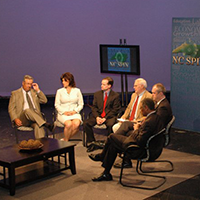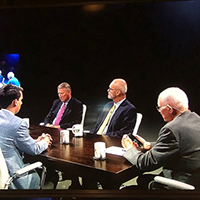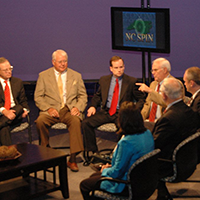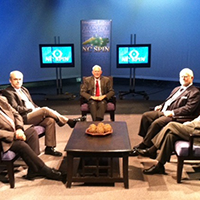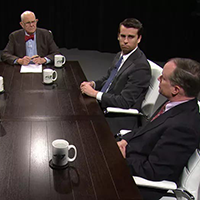How should the economy’s mix of labor be determined? Who should determine which products are produced and how many?
In a market-based economy, those decisions are made by market actors responding to the preferences of consumers.
In revealing their infatuation with tariffs and the “re-industrialization” of the US economy, however, President Donald Trump and supporters of his tariffs are attempting something that has failed time and again in history — big government central planning.
Stunning admissions along these lines are not hard to find. For instance, take this April 25 Time Magazine interview, in which Trump compared himself to the manager of a “giant, beautiful store.”
He went further. “And on behalf of the American people, I own the store, and I set prices, and I’ll say, if you want to shop here, this is what you have to pay,” he declared.
So the president is unilaterally setting prices for goods now?
But he didn’t stop there. In response to a question about his wanting companies to make goods here in America, Trump replied “Not in all cases. There are some products I really don’t want to make here,” adding that “I actually have a list” of products he does and does not want manufactured in America.
A key hallmark of socialist societies is the centralized direction of the economy by the government, directing what products are made, in what quantity, and at what prices they are to be sold. Trump’s recent comments are sounding an awful lot like that.
Moreover, America’s small businesses, and major companies ranging from electronics to automakers to footwear giants, are asking for exemptions to tariffs they realize will crush their bottom line. The Trump administration has also acknowledged the likelihood that another multibillion dollar government bailout will be in order for American farmers harmed by the tariffs. (Trump sent $28 billion in taxpayer dollars to farmers in his first term to help offset their losses due to his mini tariff war).
What better indicator of the harmful nature of tariffs is there than industries lining up begging for exemptions and farmers needing taxpayer bailouts to the tune of tens of billions of dollars?
Making matters worse, Trump’s “re-industrialization” desires are based off faulty notions.
For starters, it’s not true that America no longer makes anything.
Indeed, industrial production output, while not fully recovered from the Great Recession, nevertheless remains near all-time highs.
Increasing productivity — i.e., the ability to make more goods using less labor — is the primary culprit in decreasing manufacturing jobs. By the way, making more with less is a good thing. In fact, the only means of economic growth is increased productivity.
Want to win a bet? Ask your average tariff supporter whether China has increased or decreased its number of manufacturing jobs over the past several years.
International trade economist Scott Lincicome of the Cato Institute recently pointed to a March Financial Times article that showed that, “in fact, China has lost more than 7 million manufacturing jobs since 2011, in many of the same industries that saw such attrition in the United States decades ago.”
China’s economic growth and subsequent investments in productivity has that nation following a similar path to the US regarding decreases in employment in its most labor-intensive manufacturing industries.
Then there’s the question of how the US would handle a fundamental shift back toward manufacturing jobs.
According to Lincicome, industrial workers make up roughly 8% of the U.S. workforce today, with Trump and company desiring a shift to the 20 to 30% range reached in the post–World War II era.
To get to that level, however, “you’d need to add roughly 20 million new factory workers to our current 13 million to get to 20 percent of the U.S. workforce in manufacturing,” Lincicome wrote.
This seems an unrealistically daunting task, especially given the fact that, as Lincicome pointed out, “there are almost 500,000 job openings in the U.S. manufacturing sector today.”
The Census Bureau “recently found that more than 20 percent of U.S. manufacturing plants operating below full capacity cited labor or skills shortages as the main reason,” he added.
In short: Manufacturers are struggling to find enough workers already. Where would they find an additional 20 million to fill the positions needed to fulfill the central planners’ desired amount of manufacturing workers?
Moreover, the manufacturing jobs the tariff crowd want to bring back would largely be low-skilled, low-wage, routine work — the types of jobs typically “offshored” to developing nations like China.
Jobs producing largely low-value items will come at the expense of other, higher value-adding jobs such as research and development, services, and advanced manufacturing.
For instance, apparel manufacturing and textile manufacturing jobs in Georgia are paying $15.49 and $17.56 per hour, respectively. Production line jobs making washing machines for Samsung “start at just $16-$17 an hour,” Lincicome wrote.
By comparison, “average associate wages at Walmart and Amazon are more than $18 an hour and $22 an hour, respectively, [and] are coupled with decent benefits.”
In short, Lincicome concludes, “we’ll be gaining mediocre jobs nobody really wants at the expense of better jobs they actually do.”
How is this trade-off supposed to make America rich?
Worse still were Trump’s recent tone-deaf comments that American children “don’t need to have 30 dolls. They can have three. They don’t need to have 250 pencils. They can have five.” Here he acknowledges that his tariffs will produce greater scarcity of everyday items, but — consistent with his central-planning streak — deems himself the arbiter of what American families “need.”
In a free society, it is not the president’s — nor government’s — role forcibly to direct the labor market and production output to their desired outcomes. That’s what big-government central planning looks like. Trump’s tariff wars will not only cause substantial damage to our nation’s economy, it also represents an assault on the economic freedom that made this nation the most prosperous on earth.


